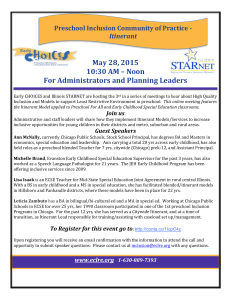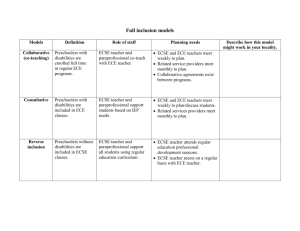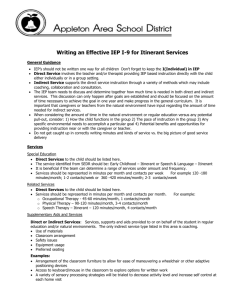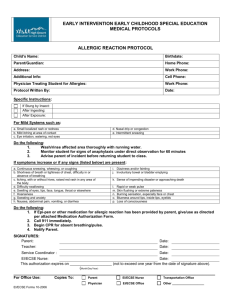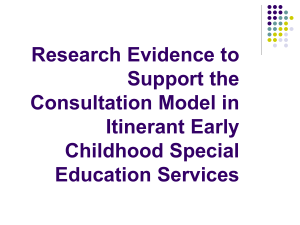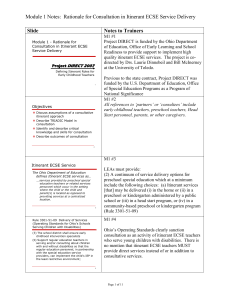DIRECT 2007 Project Module 1 - Rationale for Consultation in Itinerant ECSE
advertisement
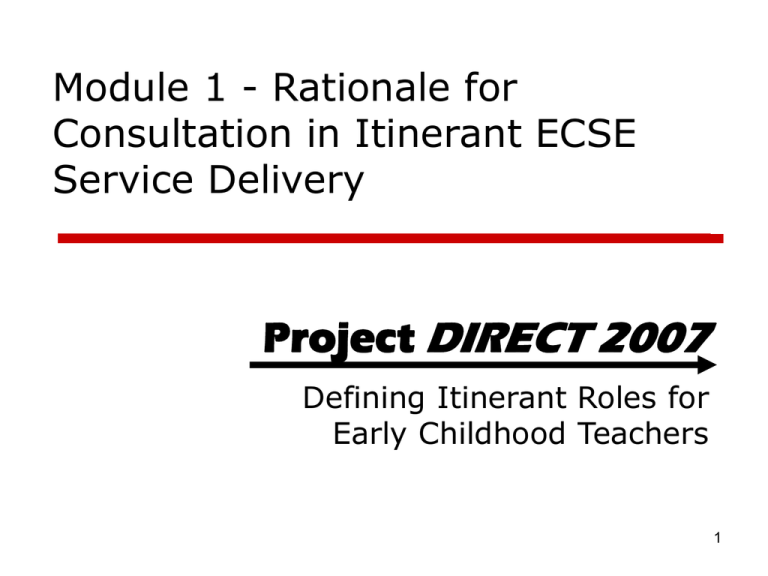
Module 1 - Rationale for Consultation in Itinerant ECSE Service Delivery Project DIRECT 2007 Defining Itinerant Roles for Early Childhood Teachers 1 Objectives Discuss rationale for focusing on importance of Itinerant ECSE service delivery Discuss assumptions of a consultative itinerant approach Describe TRIADIC Model in consultation Identify and describe critical knowledge and skills for consultation Describe outcomes of consultation 2 Itinerant ECSE Service The Ohio Department of Education defines Itinerant ECSE services as… ….services provided by preschool special education teachers or related services personnel which occur in the setting where the child or the child and parent(s) is located as opposed to providing services at a centralized location. 3 Rule 3301-51-09 Delivery of Services (Operating Standards for Ohio’s Schools Serving Children with Disabilities) (3) The school district shall ensure early childhood intervention specialists (b) Support regular education teachers in serving and/or consulting about children with and without disabilities so that the regular education personnel, in partnership with the special education service providers, can implement the child’s IEP in the least restrictive environment; 4 Trends in Enrollment in Itinerant ECSE Services in Ohio As of Fall 2005, there were 22,702 preschoolers in Ohio who received Part B services • 6,019 (26.5%) of these children received special education services in communitybased ECE settings • Ohio reported a total of 1,342 preschool teachers served these children in 2004. (www.ideadata.org) 5 Trends in Enrollment in ECSE Services, Fall 2005 Students Served (thousands) 16 14 12 10 8 6 4 2 0 EC Setting ECSE Setting Home ECE/ECSE Resid. Facility Setting Separate School Itinerant Services Outside Home 6 Importance of Itinerant ECSE Service Delivery As increasing numbers of students are served in inclusive settings such as childcare centers, families’ homes, Head Start centers, and nursery schools, it becomes imperative to define effective itinerant practices. Effective itinerant ECSE practices support inclusion—a principle that is highly valued by the field. 7 Purpose of Itinerant Service Delivery Supports inclusion in community-based early childhood settings or other natural environments. Inclusion is highly valued within the ECSE community. DEC’s Position Statement on Inclusion Inclusion represents a strong LRE (Least Restrictive Environment) option preferred by the U.S. Department of Education and the Office of Special Education Programs. 8 Defining Inclusion Inclusion, as a value, supports the right of all children, regardless of abilities, to participate actively in natural settings within their communities. Natural settings are those in which the child would spend time had he or she not had a disability (DEC, 1996). High quality itinerant services help children reach academic success by achieving IEP goals. What’s the best way to help children reach IEP goals in a community-based setting? 9 Itinerant Service Delivery: Direct or Consultative (Indirect)? Consultative Direct Assist educators and primary caregivers to provide specialized instruction and plan ways to address IEP goals within the course of the child’s typical day and routine activities. Tutor the child focused on IEP goals within the context of ongoing activities or outside of the child’s typical day. IEP-based instruction is limited to the itinerant’s visit. 10 Background on Indirect/Consultative Services Leading ECSE researchers have recommended an indirect approach to service delivery. This model is one of the Recommended Practices acknowledged by DEC, ECSE’s leading professional organization (McWilliam, 2005). 11 McWilliam’s perspective on consultation: “Integrated therapy is the coordination of therapies or consultative special education (emphasis added) within the ongoing routines of the classroom. While the therapists are working with the child and classroom teachers in the classroom, those teachers have the opportunity to see what the therapist does with the child and implement those same strategies into the rest of the week when the therapist is not present. When therapists and teachers work together to provide services and education to a child, the child benefits by receiving well-coordinated intervention.” http://www.individualizinginclusion.us/ 12 More from Dr. McWilliams “Collaborative consultation is a critical component of successful integrated therapy. By collaborative consultation we mean the exchange of information between a child’s caregiver (i.e., teachers and parents) and specialist about the child. When integrating therapy into classroom routines, research shows that four times as much communication takes place between the child's teacher and therapist than when pull-out is used, and over time families prefer their child to receive in-class therapy.” http://www.individualizinginclusion.us/ 13 Assumptions of an Itinerant ECSE Service Delivery Approach For inclusion to be successful, Wolery (2003) suggests that: • Learning environments should be of high quality • Classroom staff need support to provide individualized instruction to children with disabilities To the degree that the environment does not meet these criteria, inclusion will not be successful. 14 Consultation: Preferred Method of Itinerant Service Delivery Project DIRECT focuses on consultation because we believe it is the BEST way to support successful early childhood inclusion. While there may be LIMITED times when a direct approach is preferred, in the overwhelming majority of cases, a consultative approach is most effective at helping children achieve positive outcomes. (ODE’s Policy Statement) 15 Definition of Consultation Through a series of meetings and conversations, the consultant [itinerant ECSE teacher] helps the consultee [ECE teacher or primary caregiver] through systematic problem solving, appropriate use of social influence, and professional support. In turn, the consultee helps the client(s) [child/children] with full support and assistance from the consultant. 16 Definition continued… The purpose of consultation is to address the immediate concern or goal as well as to prevent similar problems from occurring in the future (Buysse & Wesley, 2005). 17 Consultation and TRIADIC Intervention “[A]n indirect, triadic service delivery model” Indirect and triadic—the focus of the work is still on meeting the needs of the child. However, the person who directly addresses those needs is the partner teacher or parent, not the itinerant 18 Consultation and TRIADIC Intervention In early childhood education, consultation is defined as an INDIRECT intervention model in which a consultant (Itinerant ECSE teacher) and a consultee (ECE teacher or parent) work together(in a triadic service delivery model) to address an area of concern or common goal for change. 19 The TRIADIC Model The triadic service delivery model is an INDIRECT intervention model in which a consultant (the Itinerant ECSE teacher) supports children’s development by working primarily with a consultee (ECE teacher partner or parent) rather than directly with the child. Child Itinerant ECSE Teacher ECE teacher or Parent 20 The TRIADIC Model continued… There are different ways that consultants help consultees. Some include: shares written information, Explicitly models intervention strategies, observes consultee and provides feedback to improve practice Can you think of others? 21 The TRIADIC Model continued… The intent of TRIADIC intervention is to support the child’s development by improving the knowledge and skills of the ECE partner teacher or parent (consultee). By doing so, the ECE partner teacher or parent, who usually spends more time with the child, will be more intentional and effective in her interactions with the child. 22 The TRIADIC Model continued… The ultimate effect of TRIADIC intervention is that the child’s development is accelerated as a result of more frequent intervention (because the ECE partner teacher has greater opportunities to interact with or teach the child)… 23 The TRIADIC Model continued… Also….in addition to helping the ECE partner teacher or parent increase the frequency of instruction, the QUALITY of her instruction is enhanced since the consultant has helped her learn new information and skills through the consultation process. 24 The TRIADIC Model continued… The effectiveness of the consultation model in ECSE is measured by improvement in the child’s development Improvement, however, occurs because Itinerant ECSE teachers (consultants), with the support of their supervisors, help ECE partner teachers or parents gain the knowledge and skills they need to work with the child. Triadic Model 25 The Process of Consultation Buysse and Wesley (2005, p. 18) describe an 8 stage process within CONSULTATION: • Stage 1: Gaining Entry • Stage 2: Building the Relationship • Stage 3: Gathering Information Through Assessment 26 The Process of Consultation continued… • • • • • Stage Stage Stage Stage Stage 4: 5: 6: 7: 8: Setting Goals Selecting Strategies Implementing the Plan Evaluating the Plan Holding a Summary Conference 27 Key Factors in the Consultation Model It is essential that both Itinerant ECSE teachers, their partners and their supervisors (including the ECE supervisor or administrator) agree on the intended outcome of the consultation process The overall goal of consultation is to implement the child’s IEP by enhancing the skills of the ECE partner teacher or the child’s parent. 28 Outcomes of Consultation Improved comfort level of consultee • Consultee may feel less isolated and in greater control of situation after working with consultant 29 Outcomes of Consultation continued… Increased skills or knowledge of consultee • • • • Consultee has a “bigger tool box” to use when dealing with challenging situations. Consultee understands function of child’s challenging behavior and changes the way she interacts with the child Consultee is able to provide IEP-based instruction BETWEEN itinerant visits. Consultee can better engage in problem-solving to address difficult issues 30 Outcomes continued Children’s enhanced developmental success: • Children are better able to participate in routine activities throughout the day. • Children’s interactions with others (adults and peers are improved). • Children have the consistent support they need to access the general curriculum 31 Outcomes of Consultation continued… Changes in child’s environment • The child’s classroom is rearranged to promote active exploration and interaction • Materials and expectations may be modified in accord with children’s skills 32 Outcomes of Consultation continued… Improvements in service delivery systems • The child’s Speech Pathology schedule is modified so the child can be observed by the SLP in an informal, play-based activity to determine response to peer communication attempts 33 Summary The role of a consultant is complex, challenging and very rewarding Thinking about the information presented here, identify your knowledge, skills, attitudes and dispositions that are related to serving as an effective Itinerant ECSE professional 34 Summary continued… What strengths do you already possess in the areas of knowledge, skills, attitudes and dispositions that are related to serving as an effective Itinerant ECSE professional ? What are things that you need to improve? 35 Summary continued… What would be your plan for professional development? Use the Project DIRECT Professional Development Plan to complete your plan. Professional Development Plan 36

